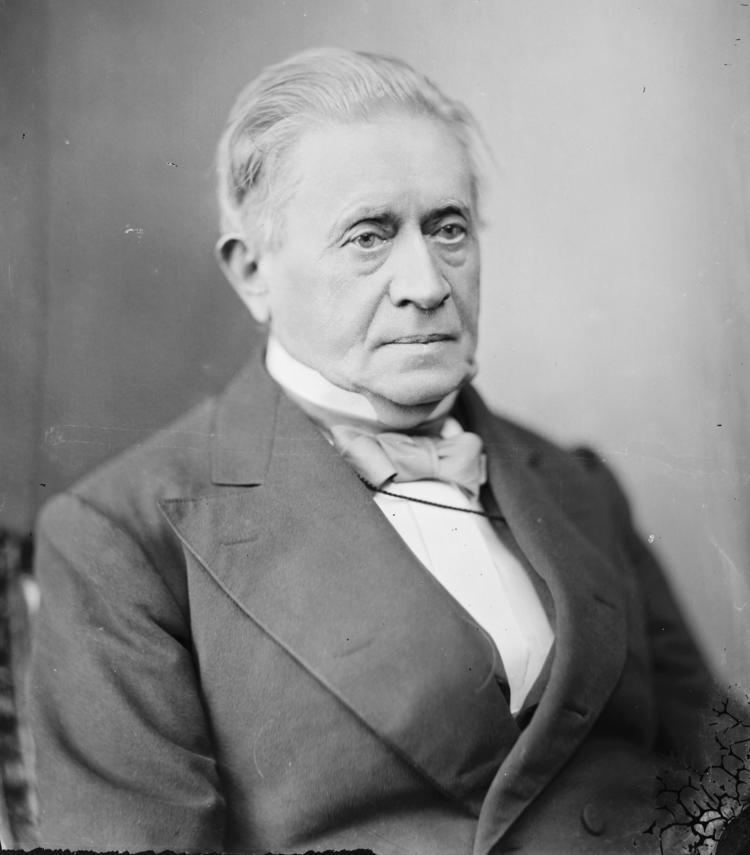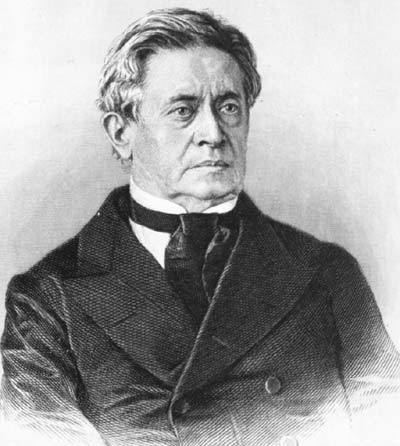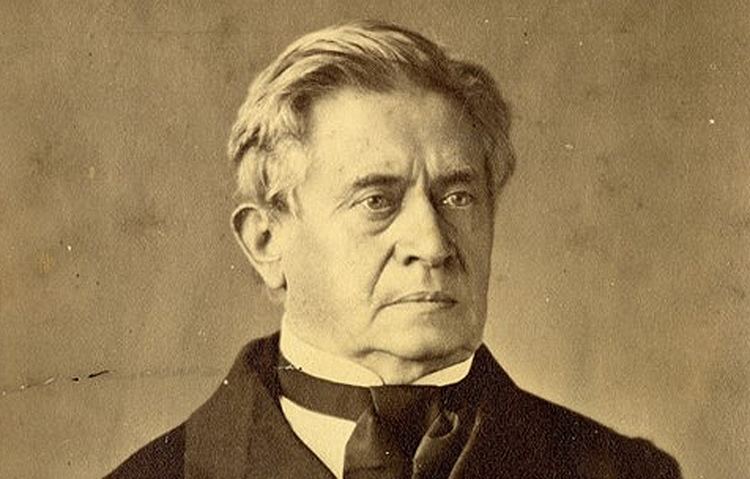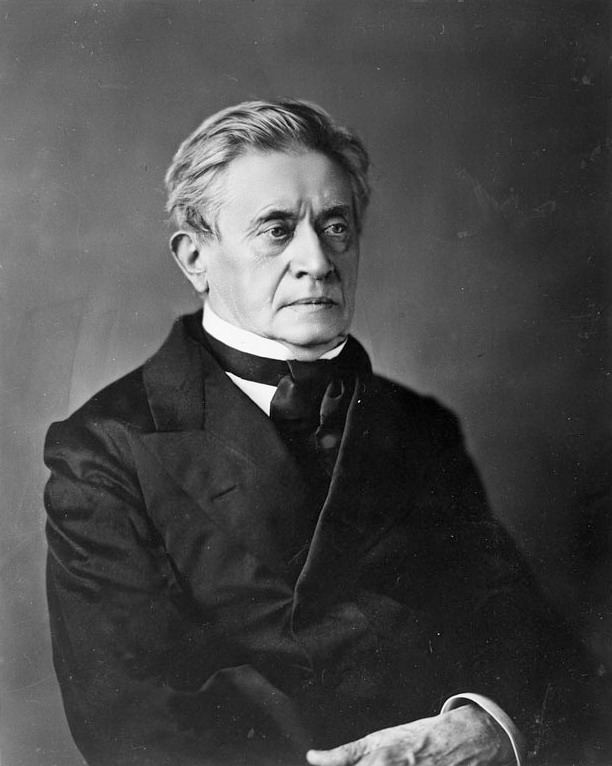Nationality American Name Joseph Henry | Religion Presbyterian | |
 | ||
Known for Spouse(s) Hariet Henry (nee Alexander) Children William Alexander (1832–1862)Mary Anna (1834–1903)Helen Louisa (1836-1912)Caroline (1839-1920) Died May 13, 1878, Washington, D.C., United States Books Reports of Explorations and Surveys: To Ascertain the Most Practicable and Economical Route for a Railroad from the Mississippi River to the Pacific Ocean Similar People Michael Faraday, Samuel Morse, William Sturgeon, Hans Christian Orsted, Andre‑Marie Ampere | ||
Notable students Thaddeus S. C. Lowe | ||
Noah joseph henry west was born today
Joseph Henry (December 17, 1797 – May 13, 1878) was an American scientist who served as the first Secretary of the Smithsonian Institution. He was the secretary for the National Institute for the Promotion of Science, a precursor of the Smithsonian Institution. He was highly regarded during his lifetime. While building electromagnets, Henry discovered the electromagnetic phenomenon of self-inductance. He also discovered mutual inductance independently of Michael Faraday, (1791–1867), though Faraday was the first to make the discovery and publish his results. Henry developed the electromagnet into a practical device. He invented a precursor to the electric doorbell (specifically a bell that could be rung at a distance via an electric wire, 1831) and electric relay (1835). The SI unit of inductance, the henry, is named in his honor. Henry's work on the electromagnetic relay was the basis of the practical electrical telegraph, invented by Samuel F. B. Morse and Sir Charles Wheatstone, separately.
Contents
- Noah joseph henry west was born today
- The life of brian joseph henry
- Biography
- Influences in aeronautics
- Later years
- Legacy
- Curriculum vitae
- Other honors
- References

The life of brian joseph henry
Biography
Henry was born in Albany, New York, to Scottish immigrants Ann Alexander Henry and William Henry. His parents were poor, and Henry's father died while he was still young. For the rest of his childhood, Henry lived with his grandmother in Galway, New York. He attended a school which would later be named the "Joseph Henry Elementary School" in his honor. After school, he worked at a general store, and at the age of thirteen became an apprentice watchmaker and silversmith. Joseph's first love was theater and he came close to becoming a professional actor. His interest in science was sparked at the age of sixteen by a book of lectures on scientific topics titled Popular Lectures on Experimental Philosophy. In 1819 he entered The Albany Academy, where he was given free tuition. Even with free tuition he was so poor that he had to support himself with teaching and private tutoring positions. He intended to go into medicine, but in 1824 he was appointed an assistant engineer for the survey of the State road being constructed between the Hudson River and Lake Erie. From then on, he was inspired to a career in either civil or mechanical engineering.

Henry excelled at his studies (so much so, that he would often help his teachers teach science) and in 1826 was appointed Professor of Mathematics and Natural Philosophy at The Albany Academy by Principal T. Romeyn Beck. Some of his most important research was conducted in this new position. His curiosity about terrestrial magnetism led him to experiment with magnetism in general. He was the first to coil insulated wire tightly around an iron core in order to make a more powerful electromagnet, improving on William Sturgeon's electromagnet which used loosely coiled uninsulated wire. Using this technique, he built the strongest electromagnet at the time for Yale. He also showed that, when making an electromagnet using just two electrodes attached to a battery, it is best to wind several coils of wire in parallel, but when using a set-up with multiple batteries, there should be only one single long coil. The latter made the telegraph feasible. Because of his early experiments in electromagnetism some historians credit Henry with discoveries pre-dating Faraday and Hertz, however, Henry is not credited due to not publishing his work.

Using his newly developed electromagnetic principle, Henry in 1831 created one of the first machines to use electromagnetism for motion. This was the earliest ancestor of modern DC motor. It did not make use of rotating motion, but was merely an electromagnet perched on a pole, rocking back and forth. The rocking motion was caused by one of the two leads on both ends of the magnet rocker touching one of the two battery cells, causing a polarity change, and rocking the opposite direction until the other two leads hit the other battery.

This apparatus allowed Henry to recognize the property of self inductance. British scientist Michael Faraday also recognized this property around the same time. Since Faraday published his results first, he became the officially recognized discoverer of the phenomenon.

In 1848 Henry worked in conjunction with Professor Stephen Alexander to determine the relative temperatures for different parts of the solar disk. They used a thermopile to determine that sunspots were cooler than the surrounding regions. This work was shown to the astronomer Angelo Secchi who extended it, but with some question as to whether Henry was given proper credit for his earlier work.
In the fall of 2014 history author Jeremy T.K. Farley released "The Civil War Out My Window: Diary of Mary Henry." The 262-page book featured the diary of Henry's daughter Mary, from the years of 1855 to 1878. Throughout the diary, Henry is repeatedly mentioned by his daughter, who showed a keen affection to her father.
Influences in aeronautics
Prof. Henry was introduced to Prof. Thaddeus Lowe, a balloonist from New Hampshire who had taken interest in the phenomenon of lighter-than-air gases, and exploits into meteorology, in particular, the high winds which we call the Jet stream today. It was Lowe's intent to make a transatlantic crossing by utilizing an enormous gas-inflated aerostat. Henry took a great interest in Lowe's endeavors, promoting him among some of the more prominent scientists and institutions of the day.
In June 1860, Lowe had made a successful test flight with his gigantic balloon, first named the City of New York and later renamed The Great Western, flying from Philadelphia to Medford, New York. Lowe would not be able to attempt a transatlantic flight until late Spring of the 1861, so Henry convinced him to take his balloon to a point more West and fly the balloon back to the eastern seaboard, an exercise that would keep his investors interested.
Lowe took several smaller balloons to Cincinnati, Ohio in March 1861. On 19 April, he launched on a fateful flight that landed him in Confederate South Carolina. With the Southern States seceding from the Union, during that winter and spring of 1861, and the onset of Civil War, Lowe abandoned further attempts at a trans-Atlantic crossing and, with Henry's endorsement, went to Washington, D.C. to offer his services as an aeronaut to the Federal government. Henry submitted a letter to U.S. Secretary of War at the time Simon Cameron of Pennsylvania which carried Henry's endorsement:
Hon. SIMON CAMERON:On Henry's recommendation Lowe went on to form the United States Army/"Union Army" Balloon Corps and served two years with the Army of the Potomac as a Civil War "Aeronaut".
Later years
As a famous scientist and director of the Smithsonian Institution, Henry received visits from other scientists and inventors who sought his advice. Henry was patient, kindly, self-controlled, and gently humorous. One such visitor was Alexander Graham Bell, who on 1 March 1875 carried a letter of introduction to Henry. Henry showed an interest in seeing Bell's experimental apparatus, and Bell returned the following day. After the demonstration, Bell mentioned his untested theory on how to transmit human speech electrically by means of a "harp apparatus" which would have several steel reeds tuned to different frequencies to cover the voice spectrum. Henry said Bell had "the germ of a great invention". Henry advised Bell not to publish his ideas until he had perfected the invention. When Bell objected that he lacked the necessary knowledge, Henry firmly advised: "Get it!"
On 25 June 1876, Bell's experimental telephone (using a different design) was demonstrated at the Centennial Exhibition in Philadelphia where Henry was one of the judges for electrical exhibits. On 13 January 1877, Bell demonstrated his instruments to Henry at the Smithsonian Institution and Henry invited Bell to demonstrate them again that night at the Washington Philosophical Society. Henry praised "the value and astonishing character of Mr. Bell's discovery and invention."
Henry died on 13 May 1878, and was buried in Oak Hill Cemetery in the Georgetown section of northwest Washington, D.C. John Phillips Sousa wrote the Transit of Venus March for the unveiling of the Joseph Henry statue in front of the Smithsonian Castle.
Legacy
Henry was a member of the United States Lighthouse Board from 1852 until his death. He was appointed chairman in 1871 and served in that position the remainder of his life. He was the only civilian to serve as chairman. The United States Coast Guard honored Henry for his work on lighthouses and fog signal acoustics by naming a cutter after him. The Joseph Henry, usually referred to as the Joe Henry, was launched in 1880 and was active until 1904.
In 1915 Henry was inducted into the Hall of Fame for Great Americans in the Bronx, New York.
Bronze statues of Henry and Isaac Newton represent science on the balustrade of the galleries of the Main Reading Room in the Thomas Jefferson Building of the Library of Congress on Capitol Hill in Washington, D.C. They are two of the 16 historical figures depicted in the reading room, each pair representing one of the 8 pillars of civilization.
In 1872 John Wesley Powell named a mountain range in southeastern Utah after Henry. The Henry Mountains were the last mountain range to be added to the map of the 48 contiguous U.S. states.
At Princeton, the Joseph Henry Laboratories and the Joseph Henry House are named for him.
After the Albany Academy moved out of its downtown building in the early 1930s, its old building in Academy Park was renamed Joseph Henry Memorial, with a statue of him out front. It is now the main offices of the Albany City School District. In 1971 it was listed on the National Register of Historic Places; later it was included as a contributing property when the Lafayette Park Historic District was listed on the Register.
Curriculum vitae
Other honors
Elected a member of the American Antiquarian Society in 1851.
The District of Columbia named a school, built in 1878–80, on P Street between 6th and 7th the Joseph Henry School. It was demolished at some point after 1932.
